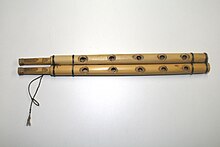Zummara
Zummara ( Arabic زمارة, DMG zummāra ) is the name used mainly in Egypt, North Africa and Iraq for a double reed pipe , which is one of the single reed instruments and is known as a double clarinet. In the Levant , corresponding instruments are called midschwiz . The wind instrument is common in Arabic folk music and in Islamic music in the Middle East .
Design
The zummara is about 50 cm long and has two parallel, equally long melody tubes made of bamboo or pole cane , which are connected to each other. Four to (more often) six holes are drilled into each tube and played in unison. The resulting from slightly different pitches beats amplify the sound. In Egypt, one of the two sound tubes can be used as a drone tube (without finger holes). The reed cut out of the bamboo at the injection opening points with the free end to the lower end of the play tube. A variant of the zummara is the maschura , whose reed points the other way around in the direction of the blow-in opening and produces a sharper sound.
Etymology and history
The name zummara is derived from the Arabic consonant root zmr , as is mizmar (also zamr , pl. Zumūr ), an Arabic double-reed instrument and originally the general term for wind instruments, as well as nzumari , a cone oboe widespread on the East African coast. Zummāra al-qirba means a bagpipe with a leather tube. Zummāra also means "throat", "throat" or "windpipe", more generally zmr refers to the process of inhaling and exhaling. The association with the donkey's scream when the instrument is blown arises from the bellows of the bagpipe, which was made from donkey skin in the past. There is also a relationship from the Arabic zmr to the Latin form summarius , " pack donkey ", " pack animal". Presumably, the linguistic classification was more about the function than the type of sound generation, because zmr can also refer to string instruments. The conceptual connection to the donkey in its role as "string bearer" has been preserved here in the Turkish string instrument kemençe , whose bridge is called esek (Turkish for "donkey").
Forerunners of the zummara have been documented in Egypt since the third dynasty in ancient Egypt (2700 BC). For the history of these instruments, called memets , see the article on the ancient reed instrument aulos . A comparable Egyptian wind instrument with a melody tube and a longer drone tube is the arghul .
Individual evidence
- ^ A b David Pino: The Clarinet and Clarinet Playing . Courier Dover Publications, 1998, ISBN 978-0-486-40270-3 , pp. 193 f . ( in Google books ). (English)
- ^ Artur Simon : Studies on Egyptian Folk Music. Part 1. Verlag der Musikalienhandlung Karl Dieter Wagner, Hamburg 1972, p. 18
- ↑ Hans Engel : The position of the musician in the Arab-Islamic area. Publishing house for systematic musicology, Bonn 1987, p. 131f
- ↑ Eric Hoeprich: The Clarinet: Yale Musical Instrument Series . Yale University Press, 2008, ISBN 978-0-300-10282-6 , pp. 12, 297 ( on google books ). (English)
Web links
- Ancient Egypt Music with pictures of the Zummara (English; accessed October 24, 2008)
- Medieval Instruments with information on the use of the Zummara in the Middle Ages (accessed October 24, 2008)

